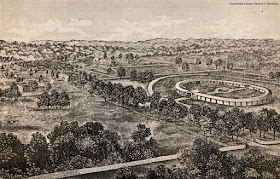This is a classic story about a boat * that is seen rising out of a strange mist on the Platte River in Wyoming.
It has been seen near several towns along the North Platte River in the late autumn.
As it rises out of the sometimes-dangerous waters of the Platte, a massive expanse of fog always precedes it.
Witnesses who have seen this ship up close state that it appears to be covered with frost—from the sails to the mast.
They report seeing a crew on board also covered with frost. These men are seen huddled around a corpse lying upon a canvas sheet.
This disturbing legend states when witnesses see this it foretells death. The crew steps back from the corpse, revealing to the witness, the body of someone they know. In each case, that person dies the same day.
 |
| North Platte River |
As it rises out of the sometimes-dangerous waters of the Platte, a massive expanse of fog always precedes it.
Witnesses who have seen this ship up close state that it appears to be covered with frost—from the sails to the mast.
They report seeing a crew on board also covered with frost. These men are seen huddled around a corpse lying upon a canvas sheet.
This disturbing legend states when witnesses see this it foretells death. The crew steps back from the corpse, revealing to the witness, the body of someone they know. In each case, that person dies the same day.
Leon Weber, a trapper, reported the first sighting of this ship in 1862.
He saw the crew step back, revealing the corpse of his fiancé who died later that same day.
Gene Wilson, a cattleman, saw the body of his wife laid out on the canvas in 1887.
Yet another witness, Victor Heibe, while chopping down a tree by the riverbank, spied the ship in 1903. Laid out on the deck was the body of his close friend. Who died that same day.
He saw the crew step back, revealing the corpse of his fiancé who died later that same day.
Gene Wilson, a cattleman, saw the body of his wife laid out on the canvas in 1887.
Yet another witness, Victor Heibe, while chopping down a tree by the riverbank, spied the ship in 1903. Laid out on the deck was the body of his close friend. Who died that same day.
This ghost story, like many, has been told and retold for years. The basic story changes but the intent--to scare-- remains the same.
* This modern legend refers to this vessel as a "ship." But in the original myth, this vessel was probably a flatboat or boat instead--for the Platte River like most western rivers is too narrow and shallow for this type of vessel.
* This modern legend refers to this vessel as a "ship." But in the original myth, this vessel was probably a flatboat or boat instead--for the Platte River like most western rivers is too narrow and shallow for this type of vessel.































